CHAPTER 2
IRIDESCENT WILDLIFE
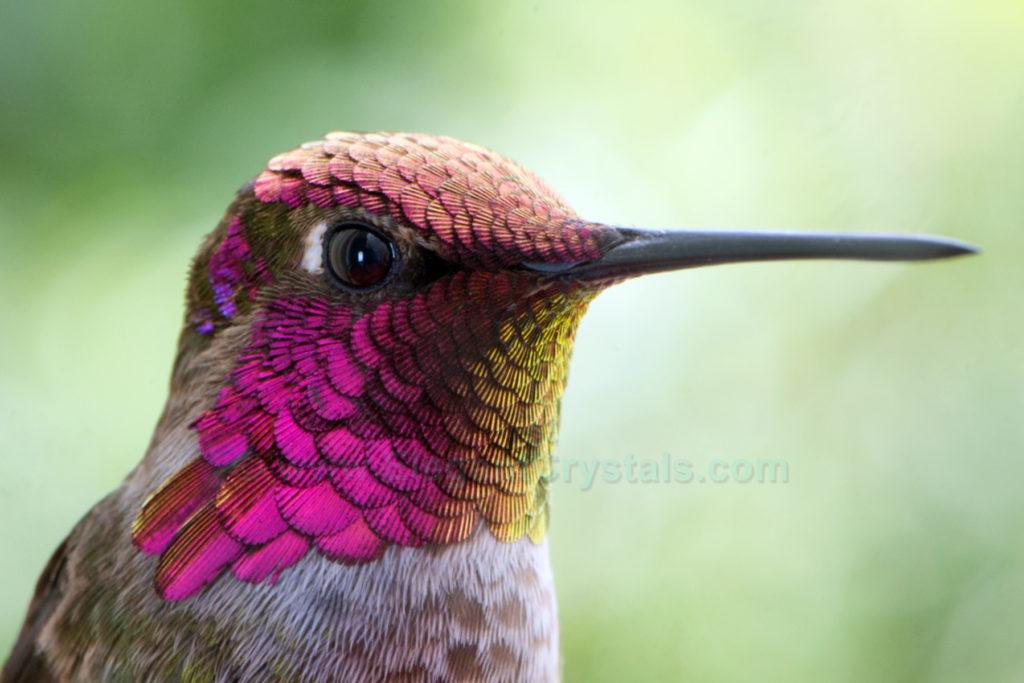
Picture #34
Male Anna’s Hummingbird, Calypte anna
Photo by Matt Knoth
Courtesy of Shutterstock.com
Some animals and a few plants rival the glorious glittering colors of crystals and gems.
What functions do these bright colors hold for the huge variety of living species that show iridescence, above and beyond their normal colors?
For that matter, do the colors and shimmering qualities of rocks have specific uses or purposes for humans, and possibly other intelligent beings?
Let’s look at the animals first.
As this gorgeous bird turns its head, the bright colors appear and disappear.
In an instant, the iridescence turns black.
Then the color flashes again, repeatedly, throughout the day.
The glints of color are not at all random.
The hummingbird is using its vibrancy to communicate with other birds and animals.
The colors are pulsing, strobing bursts of iridescent light that function similar to Morse code, since the patterns carry information for mates and predators.
These messages are carried by visible light, polarized light and sometimes ultraviolet light.
Many animals can see this UV light, which is too-high a frequency for humans to perceive.
The ultraviolet spectrum is not just one color.
Like the visible range of light, UV light covers a spread of frequencies that create a type of “ultra-rainbow” that is invisible to us, but perceptible by some birds and insects.
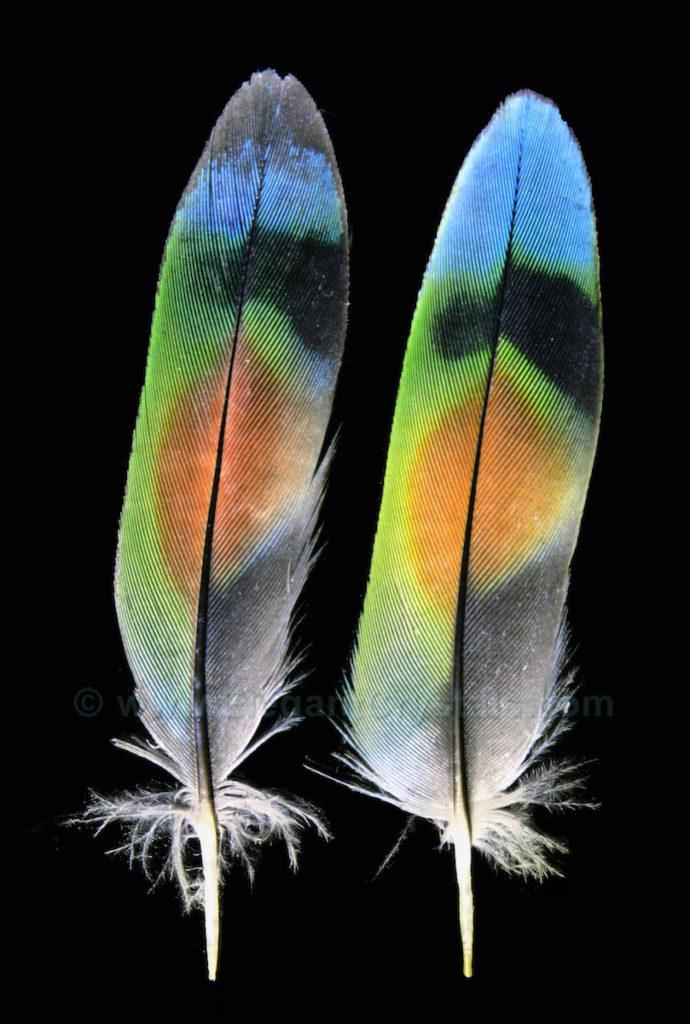
Picture #35
Peach-faced Lovebird Feathers
Rosy-faced Lovebirds
Agapornis roseicollis
Iridescent colors in animals pervade all the kingdoms of Animalia.
While some creatures are only black, white or gray, many festive organisms show amazing displays of one or more colors.
Some clever creatures exhibit all the colors of the rainbow.
Many kinds of birds show multiple colors.
These Lovebirds are practically lurid in their bright plumage.
Animals can exhibit either “pigmented” or “structural/optical” colors.
Pigments are typically a single color that does not exhibit a flashing effect.
They may be bright primary tones and hues, but the pigments don’t shimmer.
It’s the change in light that occurs with movement that defines iridescence.
Pigments are solid, unchanging colors, like, for example, purple paint.
In contrast, “optical” colors are generally created by microscopic ridges or layers of otherwise clear material.
These transparent sheets interfere with light and also act like tiny prisms.
Some animals’ blue colors – like a blue jay feather – are not due to a pigment OR iridescence.
The color is caused by the scattering of blue light off tiny colorless bubbles of air trapped in the feathers.
This is the same reason the sky appears blue.
In some animals, exceedingly thin plates of color-free transparent proteins act like layers of glass.
Stacks of these biological materials are compounded with chemicals that work like two-way mirrors.
Light bounces around in the clear zones, and certain frequencies interfere with each other to create perceptible, and sometimes brilliant colors.
The cellular mirrors can focus and amplify light, creating reflective flashes of specific colors that are even brighter than the light striking the animal.
Many organisms combine the color effects of both pigmented AND optical colors for wild visual effects.

Picture #36
Sun Conure or Sun Parakeet
Aratingasols titialis from Northeastern South America
Family Psittacid, grows up to 12” long, and may live 30 years
These friendly birds make great pets for bird fanciers.
They have amazing, bright pigmented colors that help the individuals recognize males and females of the same species.
The color becomes a medium for communication.
The shapes of feather patterns also carry information for the birds.
The movements and postures of the individual animals tell members of its species how to relate to each other- cooperation or competition?
Avian mating rituals are dazzling displays of fancy footwork and rainbow spectra.
Even birds with dense colors can flash illusory white or silvery light at certain angles.
This visual effect is called “pearlescence.”
Optical scientists use a number of terms that don’t always have precise definitions.
In similar fashion, minerals and crystals have dozens of terms for flashing color effects which overlap and sometimes blur the definition of the words.
However, almost all flashing iridescent color patterns in the natural world are caused by “thin film effects.”
At least three microscopic layers of material (even air sometimes) reflect very specific colors of light– resulting in rainbow interference patterns.
As the rays “interfere” with each other, some colors are enhanced – quite literally amplified in brightness, while others are cancelled out– or at least dimmed.
This adds variety to the mix.
All the colors twinkle and shift whenever any of the micro-crystals move, or when the spacing between layers or structures changes.
The color of light we see will vary when the position of the illuminating light is moved, when the animal moves, or the observer’s head is moved from side to side.
In fact, that is how we can spot true iridescence: when each eye sees a different hue or even a different color.
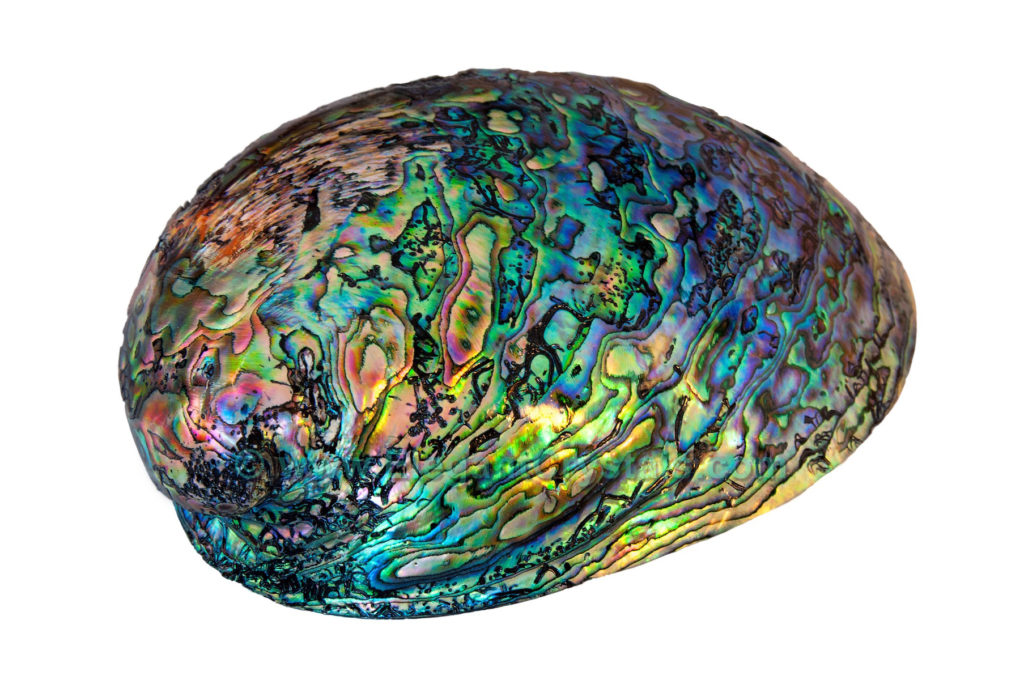
Picture #37
New Zealand Paua Shell
Haliotis iris, family Haliotidae
Blackfoot Paua or Rainbow Abalone
Photo by Elen11
Courtesy of Shutterstock.com
These ultra-vivid shell colors are beautifully patterned in swirls and layers, just like the ocean’s floor.
The colors create a way to camouflage the abalones from their predators.
Despite the sturdy shells, Paua species are hunted and eaten by starfish, lobsters, octopi, crabs, sea-stars and fish.
The shallow ocean environment glitters with sunlight shifting in the constant water-wave patterns.
The shells mimic the colors of water and sunlight, and also the patterns of waves and seaweed.
Sometimes the best way to hide is in plain sight!
Many abalones have delicate mother-of-pearl colors on the inside of the shell.
This brightly patterned Paua species uses microscopic biological crystals on the outside to build up the color effects.
The same types of crystals are found as much larger mineral versions, in caves and pockets in the earth.
The mineral is called “aragonite.”
The abalone are growing rocks on their shells!
Aragonite is a translucent form of calcite crystal.
Calcite can also be perfectly clear.
The abalones’ organically-formed crystal is made of calcium carbonate, a soft type of mineral that the Paua can manufacture from ocean chemicals.
On the microscopic level, the aragonite is transparent.
The many layers of thin crystals create a mirror-box effect that bounces light around in wild patterns.
Jewelry makers carve abalone shells into wonderfully wearable fashion designs.
The aragonite layers are interspersed with thin sheets of water.
If this water dries out, the colors disappear and shift to pure white.
Most abalone jewelry is sealed with a clear coating to prevent water loss.
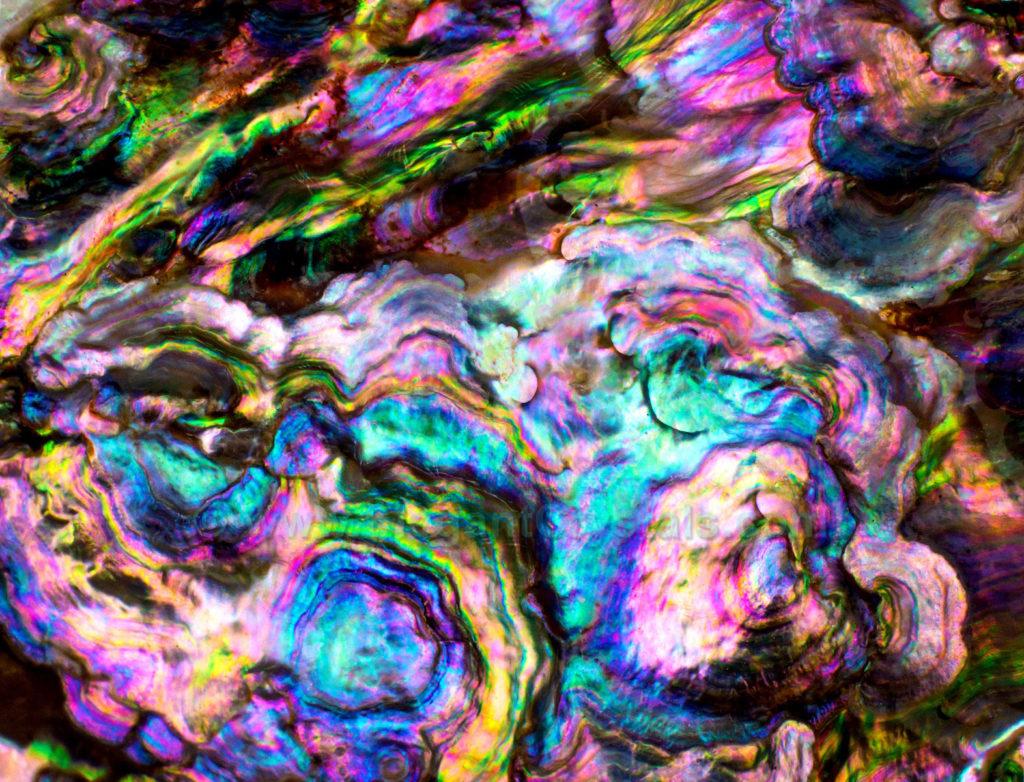
Picture #38
Closeup Photo of Rainbow Abalone
Photo by Ievgenii Tryfonov
Courtesy of Shutterstock.com
Nature’s art is always perfectly beautiful.
The seemingly random patterns display the results of DNA programming within this crystalline shell.
These vortex designs occur throughout nature:
in weather patterns,
water whirlpools,
color swirls in animals,
electron orbits and
galaxies.
The shell’s sophisticated layout creates a 3-dimensional effect that is an optical illusion.
The surface is relatively smooth, with some slight variations in height.
This type of apparent three-dimensionality also occurs in the iris rainbows in clear quartz crystals.
The fissures and cracks that form in quartz are almost perfectly smooth and flat.
The crystal’s iris areas may only vary by a few thousandths of an inch, yet the photos look like vastly extended landscapes on a gargantuan scale.
Likewise, the distinctive striation patterns on the side of a crystal can take on many dimensional appearances, but still be smooth enough that you can’t feel the ridges with your fingertips.
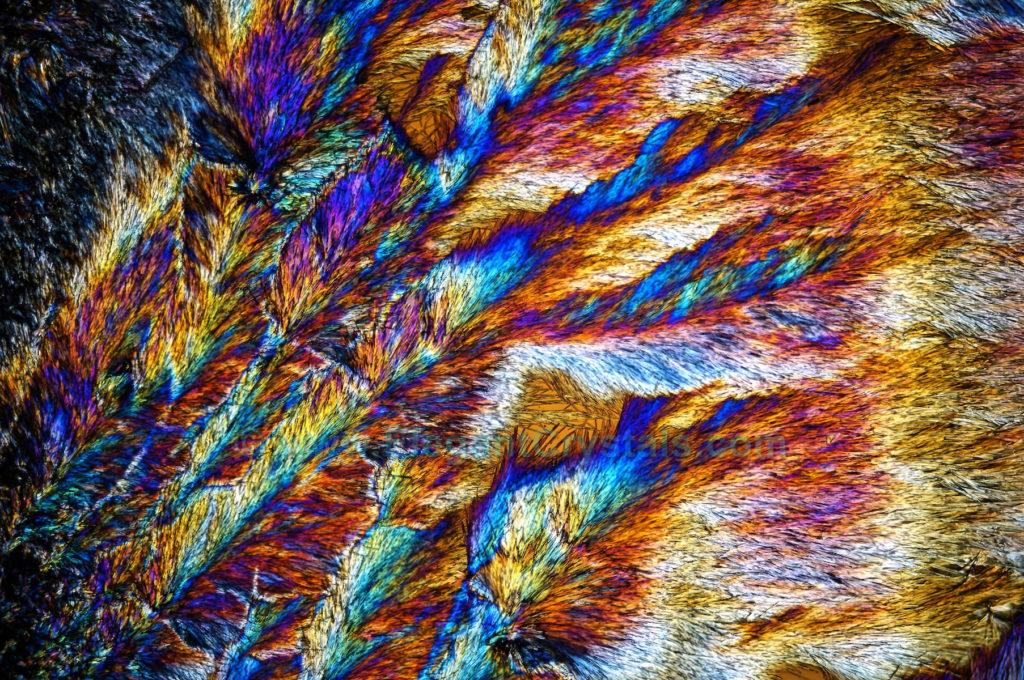
Picture #39
A Thin Film of Crystallized Menthol Oil
Photo by Ivan Gladun
Courtesy of Shutterstock.com
My quartz photography is geared to capturing images that I can see with my eyes.
Sometimes, my limited human eyes can’t resolve a lot of detail in the crystals, yet I know something interesting is going on.
I might see some glittering hair-thin patterns that I know will be fascinating when magnified.
With sophisticated Nikon macro lenses, I can shoot images from tiny areas inside a crystal- even a 1mm patch of iris inclusions.
This requires accurate fine-focusing and a very sturdy tripod.
Solid stone or concrete floors help a lot too.
At huge magnifications, an image can go out of focus if it moves a thousandth of an inch.
When I do focus accurately, my 1-inch-long rainbow subject matter can be printed as 8-foot-long pictures.
Here are some examples of giant prints on flat metal sheets.
The image here was created at a very high magnification.
The artist uses a microscope with crystallized/dried chemicals on a glass slide.
Cross-polarized light generates the colors in the clear or white chemical crusts.
The optics of the camera/microscope combination can enlarge miniscule areas by hundreds or thousands of times.
No book on shimmering crystals would be complete without the fantasy visions created by polarized light micro-photographers.
Please enjoy the microscopic spectral landscapes of Justin Zoll and Tom Wagner at the end of the book.
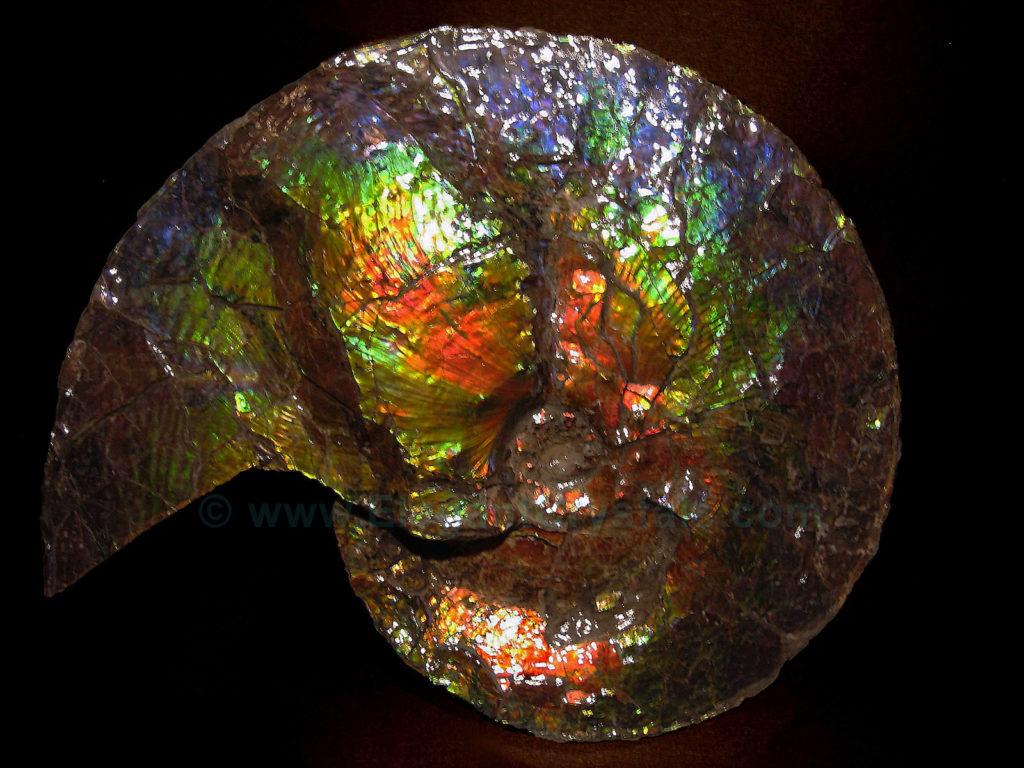
Picture #40
Ammonite, Variety Ammolite
Placenticeras meeki
What is the largest iridescent stone display in nature?
Quartz crystals can have iris rainbows in the multi-inch range.
I have seen a few with 8-inch-long vivid rainbows generated by silvery fissures in large crystals.
I can imagine a 12”-inch-long rainbow in a giant quartz crystal, but I have never actually seen one.
Legends tells us of enormous discoveries, 20-foot crystals, Or 40 feet and larger, but few pictures exist.
The largest quartz crystals tend to be milky white and opaque, so any rainbow fissures would not be visible.
Have you ever seen large, flat polished pieces of labradorite, also called Spectralitetm?
This amazing crystalline feldspar rock occurs as large boulders from Madagascar.
The stones can be cut and polished into foot-long specimens of natural shimmering artwork.
The color combinations are unusual, as you can see in Chapter 7.
The award for huge natural gemstone rainbows goes to the fossil species known as ammolite (iridescent ammonites.)
These relatives of squid lived 70 to 75 million years ago.
Their shells are biologically formed layers of crystals of aragonite, like the abalone we saw earlier.
Where abalone is called “Mother of Pearl,” ammolite is sometimes called “Grandmother of Pearl” for its vivid displays.
The best colored fossils are found in Alberta, Canada, on the east side of the Rocky Mountains.
The largest rainbow specimens exceed 40 inches in width!
The fossil above is 1-foot-wide, displaying a larger rainbow than any crystal I have seen.
Perhaps a giant block of clear calcite crystal might have a huge rainbow, but I have never seen one, or even a picture of one.
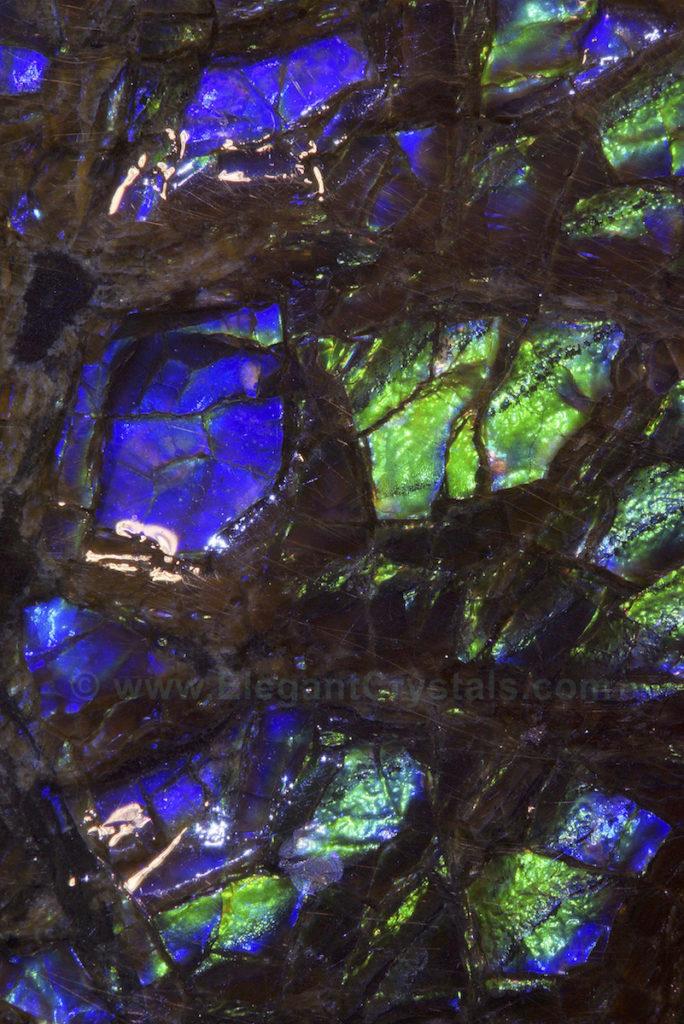
Picture #41
Ammonite, Variety Ammolite
Placenticeras meeki
Ammolite colors are usually red and green.
Occasionally I see a piece big enough to photograph in the blue variety.
Purple pieces are elusive and fragile.
The red crystalline layers are the thickest of all- up to 8/10th of a millimeter (1/20th of an inch.)
Then the various color layers get thinner, down through orange, yellow, green and blue.
Purple is so thin, it tends to break off from the shell and crumble.
Almost all ammolite has to be polished to bring out the shine.
During the polishing, the color’s thickness decreases again, by a factor of 50% or more.
The shells are then sealed with clear epoxy to preserve the colors.
These fossilized creatures have been in the ground over 70 million years, subject to earthquakes, volcanos and meteor shocks.
Water, acids and chemicals in the ground flow through the stones and fossils, leaving a rough, pitted finish.
Craftsmen from the Kainai Nation (or Káínawa) dig and polish the fossil gems for worldwide jewelry distribution.
An estimated 600,000 ammolite rainbow slices have traveled to buyers around the world in the last 40 years.
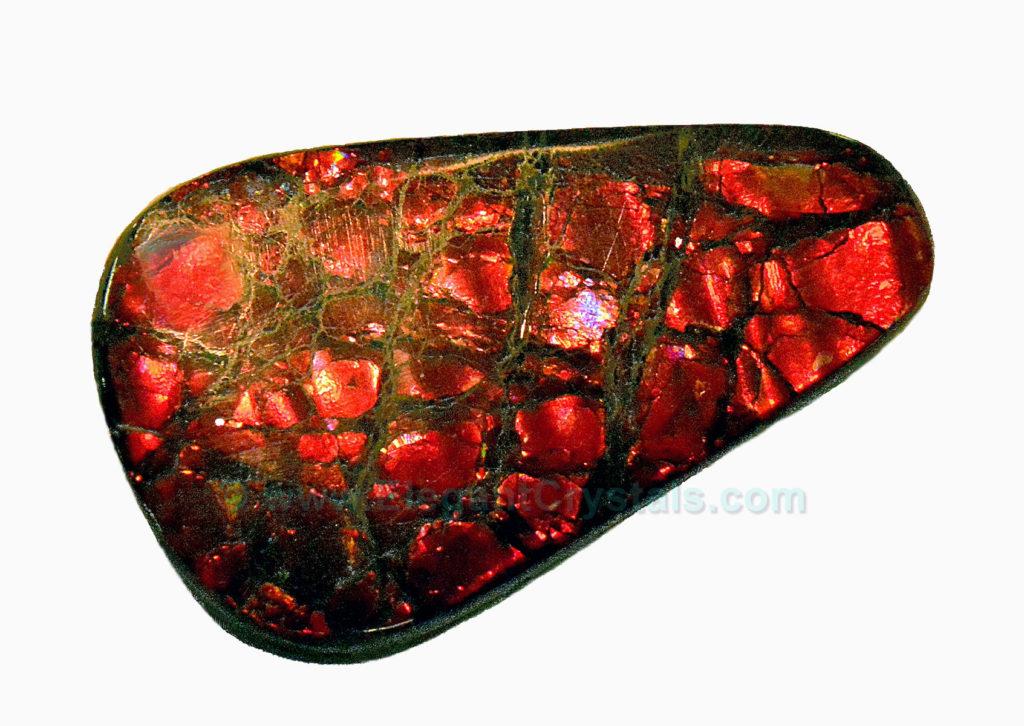
Picture #42
Ammonite, Variety Ammolite
Placenticeras meeki
Ammolites are extinct- they died out along with the last dinosaurs.
Rainbow-lovers are enormously lucky that colorful petrified fossils are found in Alberta, Canada about 160 miles south of Calgary.
Similar fossils are located in Northern Montana, Utah, and quite a few in Madagascar.
The African variety, from the island republic of Madagascar (formerly the Malagasy Republic) tend to be smaller; plentiful, yet much less colorful.
All the fossil color layers have to be epoxy-sealed or covered with sturdy clear material (doublets) in all ammolites, to protect the rainbows from chipping away.
Each ammolite fossil is now a petrified stone, and no longer a shell.
As a variety of calcite, it is quite soft and easily scratched.
(Mohs hardness scale at 3 to 4)
Ammonites were relatives of sea creatures such as the modern Nautilus, octopus, squid and cuttlefish.
They are all in the phylum Mollusca.
Ammonites lived at depths up to 300 feet in the ocean.
Their rainbow magic comes from the animal’s ability to create shells with alternating layers of flat crystals and long crystals.
The crystals don’t have any inherent color, as all the various vivid hues are created by light reflections and refractions.
For the longest time, I thought the colors were created by silica, like in opals.
It turns out there is virtually no silica in ammolites, as all the color effects are created by prismatic calcite/aragonite crystals.
We’ll see some great opals in Chapter 7.

Picture #43
Yellow Tang
Zebrasoma flavescens
Yellow Sailfin Tang or Yellow Surgeonfish
Habitat: Hawaii
Fish are experts at creating biological crystals that flash colors underwater.
They often have pigment colors as well as iridescent/optical colors.
The color ranges are astounding.
Not only are the colors intense, but they flash and shimmer through other transparent layers in the scales.
Scale materials do not contain any color.
The color comes from reflections off biologically formed guanine crystals in the fish skin.
Guanine is one of 6 key components in DNA.
All animals have learned to utilize guanine for a variety of biological functions.
In fish, it forms in stacks of long flat crystals oriented on the skin of the fish.
Evolution has optimized the crystals to reflect light.
Fish do a much better job of making precisely faceted guanine crystals than scientists can create in a laboratory.
Nature has perfected the tiny prisms.
In essence, the fish is crystallizing part of its DNA into an optical system for communications and predator evasion.
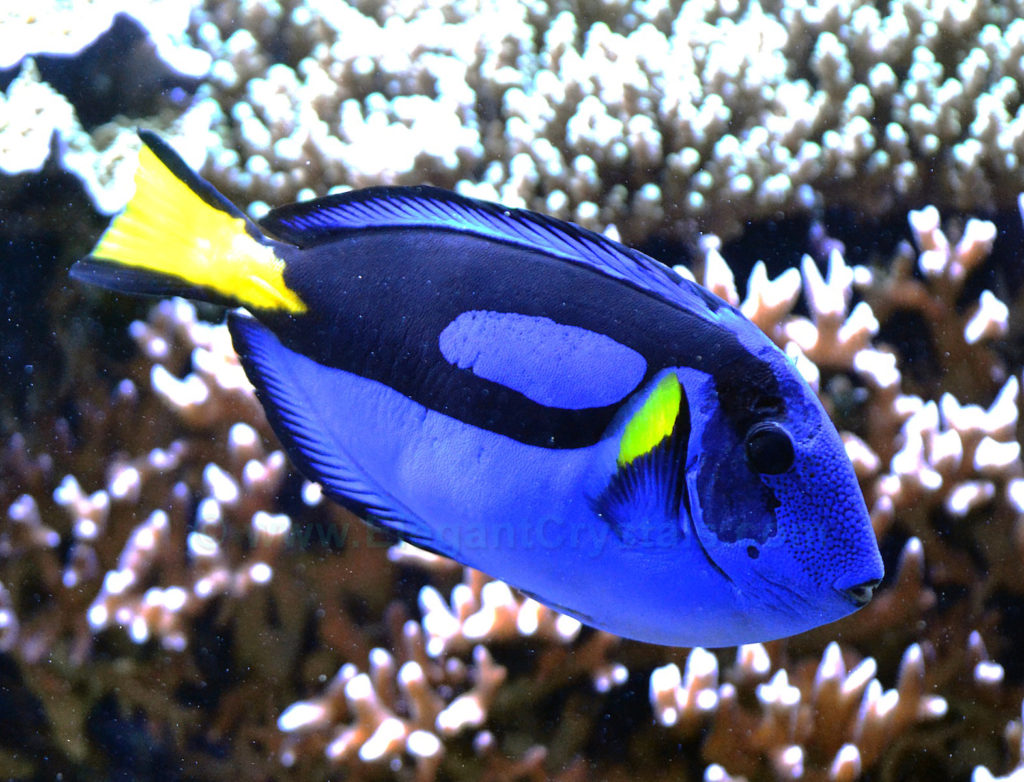
Picture #44
Indo-Pacific Surgeonfish
Paracanthurus hepatus
Royal Blue Tang, Hippo Tang, Flagtail Surgeonfish,
Pacific Regal Blue Tang, Blue Surgeonfish
You can just about see this blue tang fish shimmer in my photograph.
Note the shiny light and dark blue areas.
Sunlight gleams off its flanks as the many organic crystals in the skin and scales work together synergistically to aid in the species’ survival.
The blue colors of glistening scales mimic the view of surface waves glittering in the sun.
Ecologists surmise that the fishes’ special lighting effects confuse predators and thwart their attacks.
Once the guanine crystals in the fishes’ skin create “interference colors,” the light shines through 3 types of crystalline substances in the scales.
These are predominantly hydroxy-apatite crystals, similar to both tooth enamel and tooth dentin.
Dentin is always transparent, and tooth enamel is very clear in thin layers.
In the fish, these bio-crystals are held together by water, also clear, and a clear collagen-protein glue.
Enamel forms a hard-protective layer on the outside of the scales.
Everything is transparent to the guanine’s colored- light emissions.
The glistening scale layers are 1,000 times thinner than a human hair.
Fish dazzle and attract their mates through this vivid coloration.
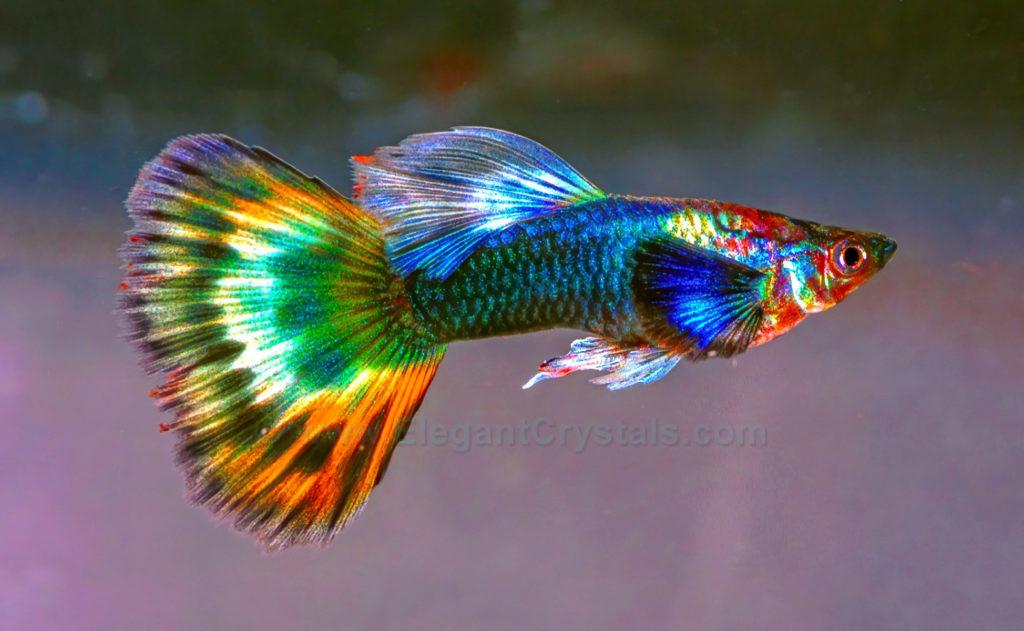
Picture #45
Fancy Guppy- Poecilia reticulata
Rainbow Fish or Million-fish
Photo by Karel Zahradka
Courtesy of Shutterstock.com
When I see particularly lurid animal pictures posted on the Internet, I always wonder if some creative artist has digitized them to add spectacular colors.
I did a little research and discovered these rainbow fish are astoundingly real.
Few creatures express such a wide range of colors.
Indeed, the full spectrum exists on this one tiny fish.
What a show-off!
The girls and boys have no trouble recognizing each other.
Only the males have intense color patterns, and every individual has different colors.
Fish fanciers pay top dollar for fine specimens.
Several types of structures create color effects in these fish.
Solid pigments occur in some types of cells; glowing iridescence reflects off the skin-cell crystals, and some cells focus and reflect white light.
You can see all these effects in schools of fish wheeling and turning in graceful watery waltzes.
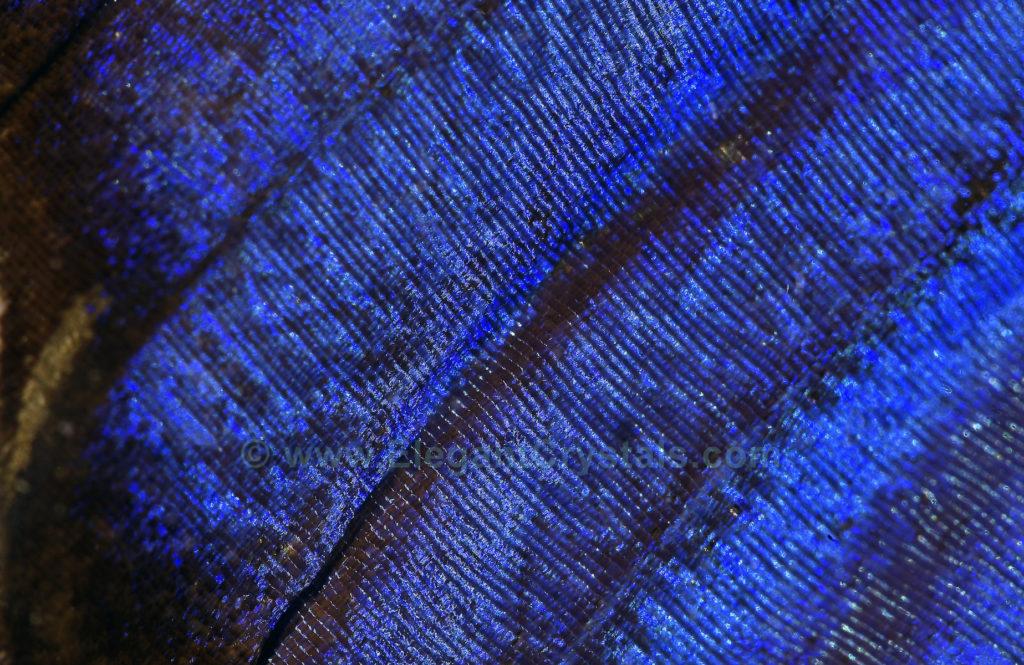
Picture #46
The Blue Morpho
Morpho amathonte, Peru
What have we here- a piece of woven fabric?
Skin, scales or feathers?
Many people recognize the name Morpho as a group of huge butterflies from South America.
These exhibit true iridescence from the top surface of the wings, with colors shifting from light blue to deep blue to all shades of purple plus invisible ultraviolet colors.
The bottom of the wing is mostly shades of brown (melanin pigments) with dramatic “eye spots.”
When sunlight shines THROUGH the wings from either side, the brown eyespots jump out at you in a scary way.
The insects use this “startle response” to drive away predators.
When sunlight glances OFF the tops of the wings, the fabulous colors appear.
During flight, the changes in angles of the wings yield alternating blue and brown colors that confuse animals that hunt the Morphos.
Butterflies have a lot of enemies- wasps, ants, parasitic flies, birds, snakes, toads, rats, lizards, dragonflies, monkeys, frogs and spiders.
It’s a good thing that they are not tasty to humans: everything else eats them.
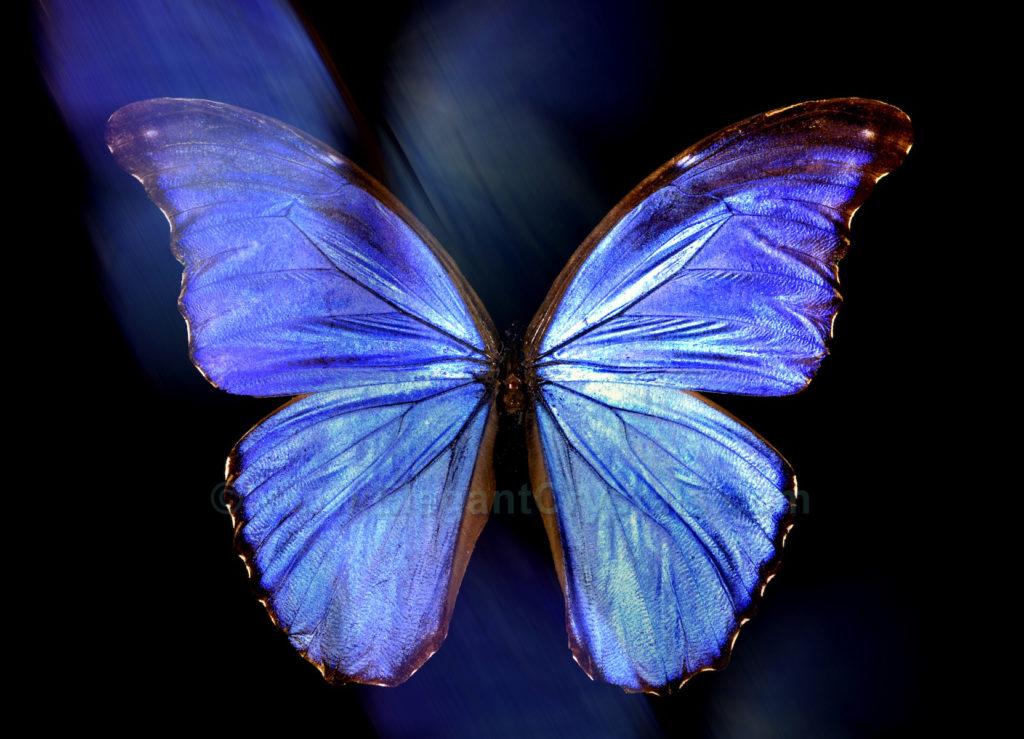
Picture #47
The Blue Morpho
Morpho amathonte, Peru
The mechanisms that control colors in the Morpho are “tuned-cells” that evolved to the size of the wavelength of blue light.
These sensitive branching nanostructures can vibrate from light or sound pressure, heat, or chemical changes in the atmosphere.
Subtle color variations make it hard for their hunters to visually focus on them.
Chitin, a structure-forming polysaccharide sugar, creates the wing scale cells.
These are “photonic crystals” that generate illusory colors by reflecting specific wavelengths of the incoming sunlight spectrum.
The chitin itself is transparent- absolutely free of colors.
Other specialized layers of thin, colorless chitin then further refract the “structural light.”
The colors are consistent across a 100-degree angle of view.
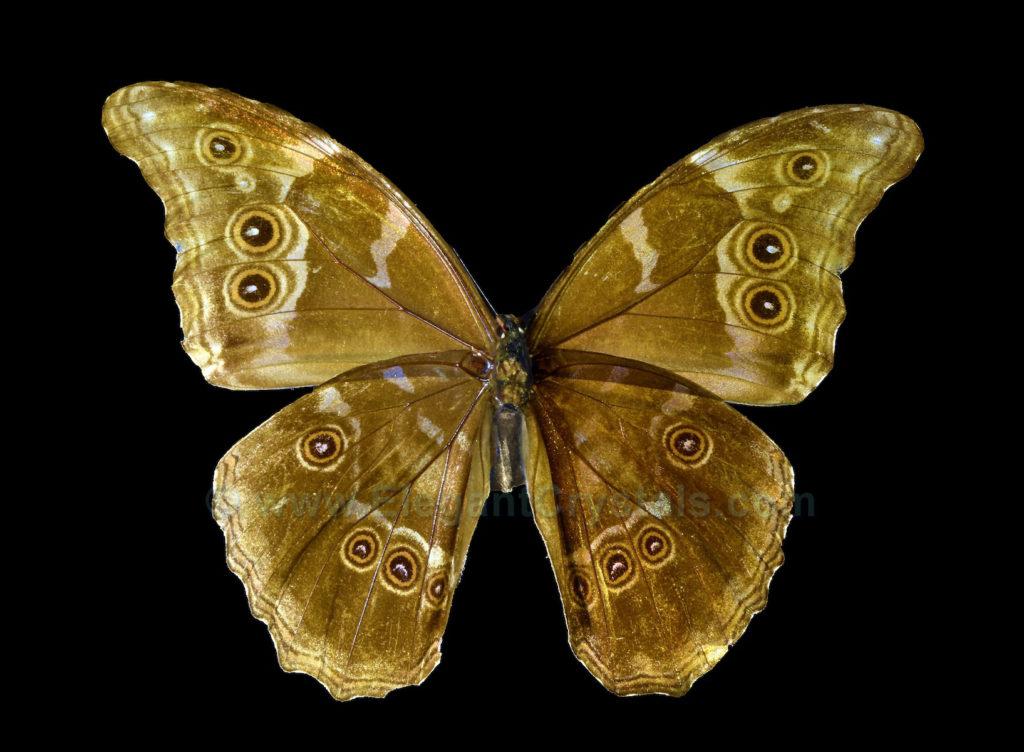
Picture #48
The Blue Morpho
Morpho amathonte, Peru
Eye spots on the Morpho give the impression of large groups of big animals.
This helps to dissuade predators from eating the butterfly.
These insects have few defenses, as their claws are small, and the butterfly lacks teeth.
The brown pigments are melanin, the same compound that causes tanning in human skin.
This picture shows what the bottom of the wings looks like.
It also looks similar when sunlight shines THROUGH the wings.
Brown and blue flashes appear as the wings move up and down in flight.
This is visually confusing to watch, just as evolution intended for the Morpho’s survival.
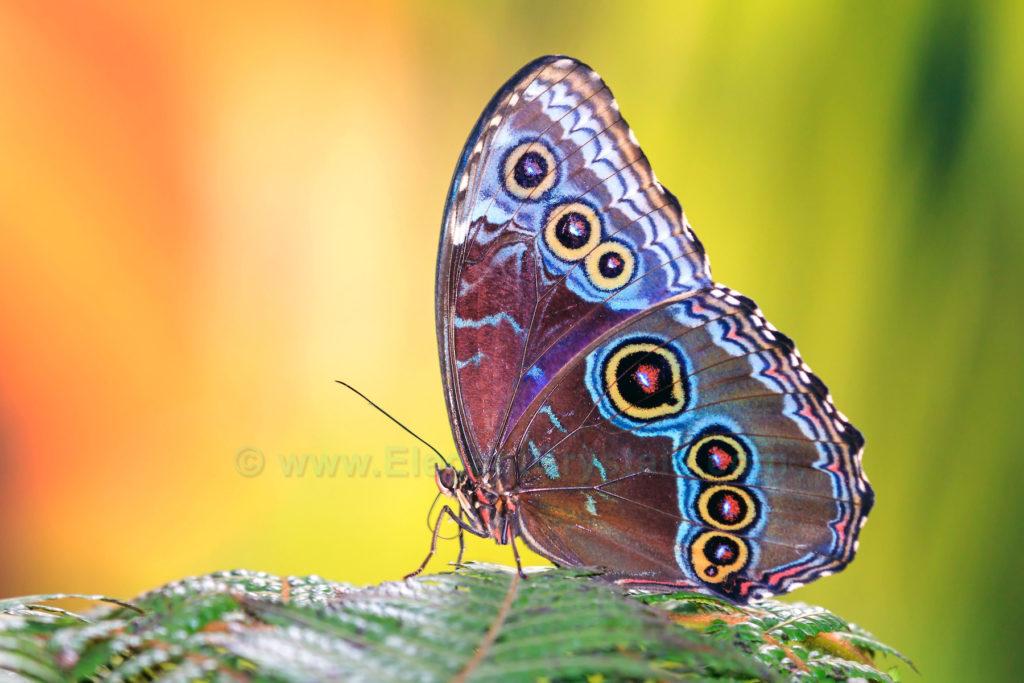
Picture #49
Morpho menelaus, the Menelaus Blue Morpho
Photo by Dennis van de Water
Courtesy of Shutterstock.com
This variety of Morpho incorporates iridescent colors which contrast with pigment colors on BOTH sides of the wing.
Nature creates lovely artistic displays in all her creatures, including iridescent worms, shining snakes and glowing algae.
There is even an iridescent-furred golden mole species.
Some monkey fur also shimmers with bright blue colors.
Scientists believe the glowing cellular structures in many animals help reduce friction while burrowing through sand or dirt.
The scaly cells shed water and dust, as well as trapping heat/infrared rays for temperature regulation in the body.
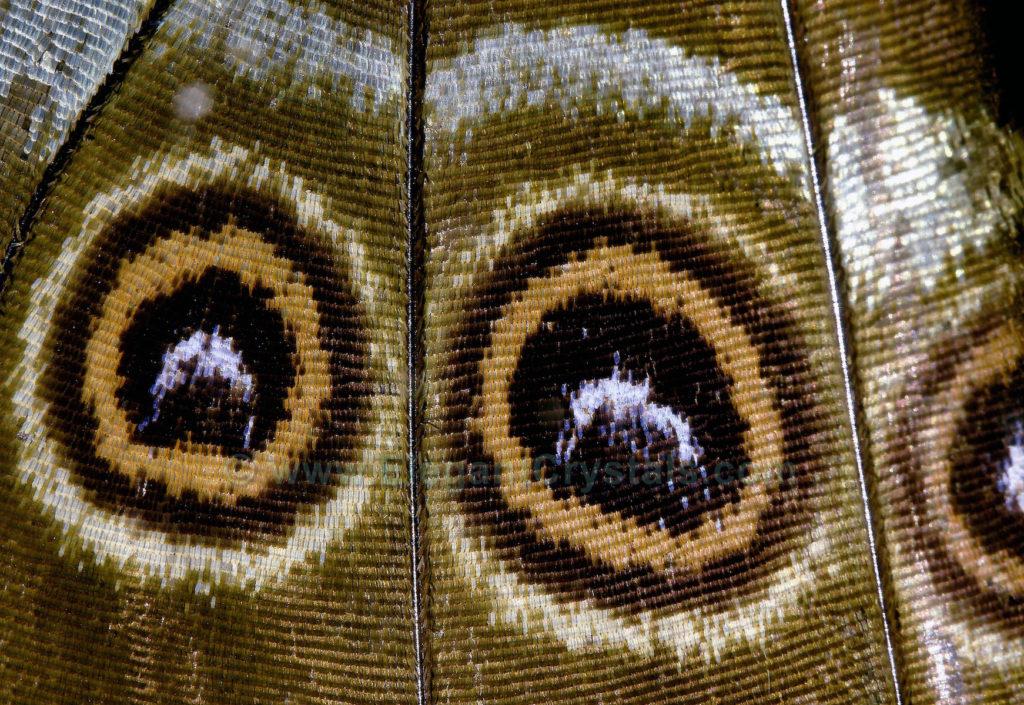
Picture #50
The Blue Morpho
Morpho amathonte, Peru
Closeup photography of butterfly wings yields images that look like the weavings in fabric and rugs.
These patterns are consistent DNA expressions based on millions of years of evolution for successful species survival.
Pigmentation is created by microscopic cellular “factories.”
These designs are often mimicked in human weavings and artworks.
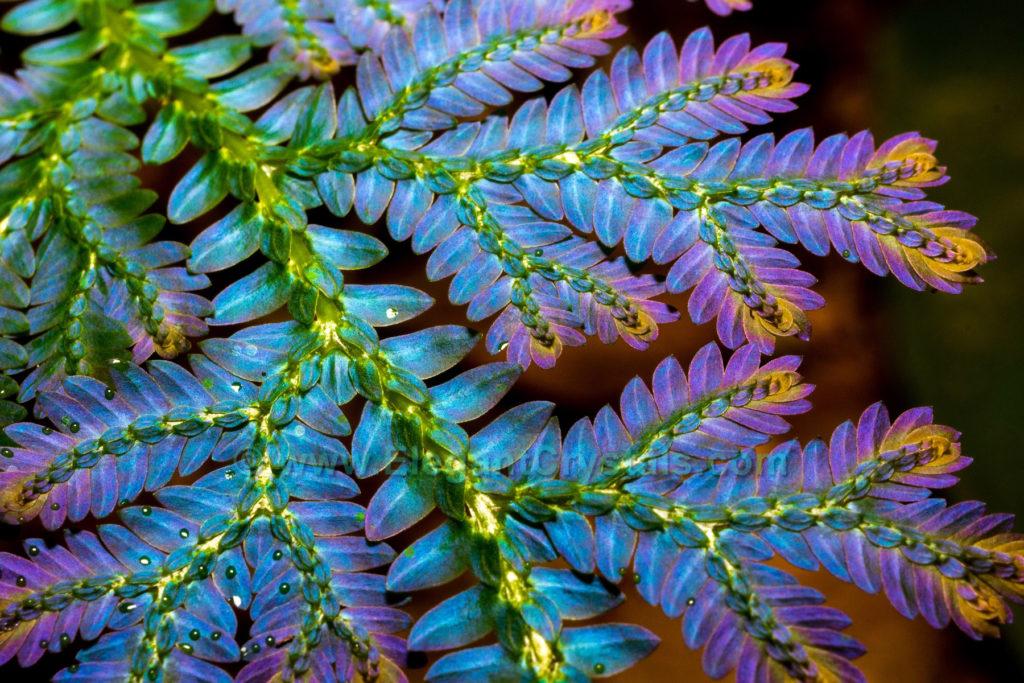
Picture #51
Tropical Malaysian Fern Leaf
Selaginella willdenowii
Photo by Shazrul Edwan
Courtesy of Shutterstock.com
Five distinct colors shimmer on this ground-floor fern from the rain forests of Malaysia.
Plants have completed a process of “parallel evolution,” where they have evolved optical structures in their tissues that create iridescent colors similar to animal spectra.
Many parts of plant tissues can create an optical iris effect- a living rainbow.
Waxy coatings (cuticles) shimmer on many leaves.
The “skin” cells act like flat (tabular, tabby) crystals that also focus light inside the leaves for photosynthesis.
Circular cells and round components or air bubbles act like little crystal balls- a perfect focusing lens.
Even the chlorophyll in chloroplasts glows.
Without going into too much detail, here are the optical mechanisms that create changeable colors in both plants and animals:
Thin film interference- three or more layers of refracting materials
Multilayer interference- layers could be from liquid, solid, or gaseous materials
Diffraction gratings- repeating triangular ridges that act like multiple prisms
Scattering- small particles reflect blue light frequencies
Photonic crystals- materials that take on prismatic crystal shapes
Liquid crystals formed by cholesterol.

Picture #52
New England Forest, late fall, 1971
You can simulate iridescence by reflecting pigmented colors in moving water.
It is the dynamic shifting nature of the reflection that looks like an “iris effect.”
Iridescence is a function of movement, and is difficult to capture in a still photo.
The iris effect in plants is created by a variety of materials.
Different species, and different parts of the plant, may use:
striated cellulose fibers,
up to four distinct reflective layers of cuticle wax,
cytoplasm in plant skin cells,
plastid or chloroplast sub-structures.
There are even biologically formed silica micro-globes in plants that create color effects similar to opals.
Trees contain tiny plant-assembled quartz/silica crystals called “phytoliths” that shimmer brightly, as seen in a polished piece of redwood lumber.
The phytoliths not only reflect light like mica does, but they provide significant strength to hold trees up, to heights of hundreds of feet.
Studies in plant iridescence are still in their infancy.
Many secrets will yet be revealed within the plant kingdom.
For instance, researchers recently discovered that a primary function of plant iridescence is to serve as an effective sun block.
Ultraviolet (UV) light is reflected away from the leaves to prevent sunburn in delicate ferns that evolved to live on the dark forest floor.
The sheltered and shadowed ferns usually only receive 1% of the normal strength of sunlight.
Even momentary shafts of direct sunbeams can damage ferns in the absence of an effective UV defense mechanism.
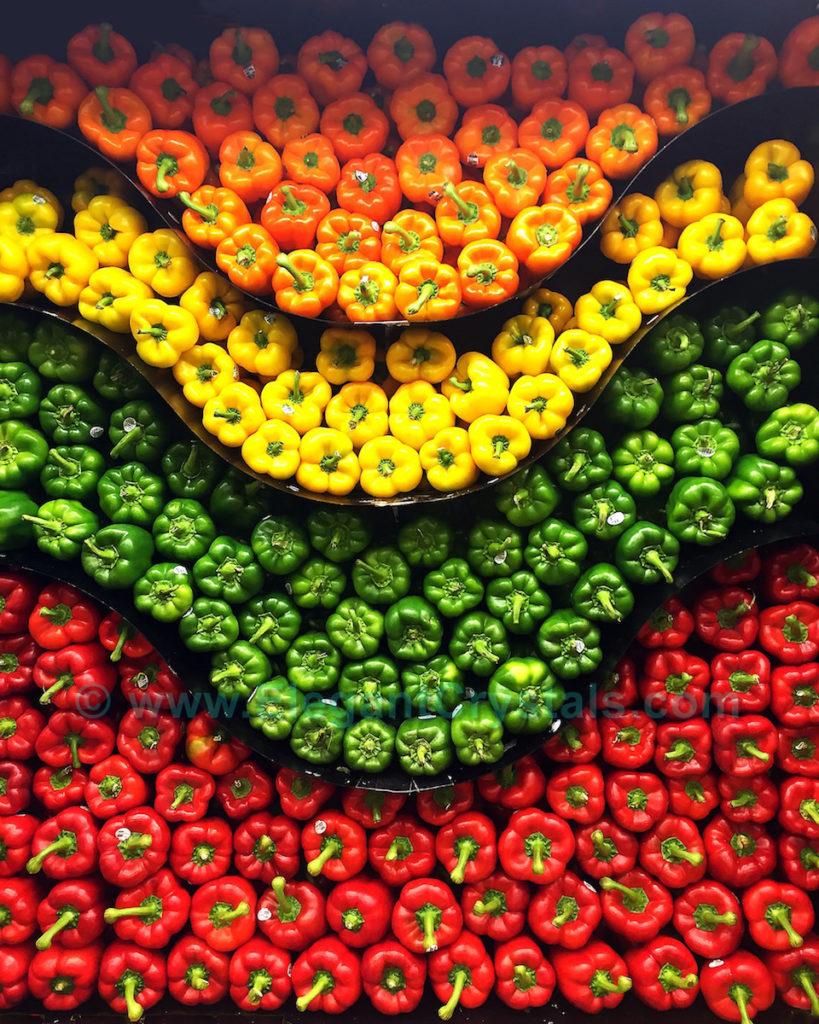
Picture #53
Bell Pepper Rainbows at a Safeway Store
San Francisco, 2019
The clever grocer puts water sprays above the produce.
It keeps the food hydrated, while the moving water rivulets create an attractive shimmering effect on these vivid peppers.

Picture #54
Panther Chameleon
Furcifer pardalis from Madagascar
Photo by T-I
Courtesy of Shutterstock.com
This is another animal that looked too lurid for reality.
I confirmed that it really does display amazing colors like these.
Different color patterns express in every single animal, but only in the males.
The male chameleons can change their colors dramatically and quickly.
Iridescent structures create the complicated optical effects.
The rainbow patterns break up the outlines of the animals to confuse predators.
And they look sexy to their mates.
There are two superimposed layers of iridescent cells that reflect light.
Some layers also contain solid pigments.
The lizard can move microcrystals in the top skin layer with tiny muscle contractions that shift the perceived colors.
The iridescence interacts with the inbuilt pigments.
A relaxed chameleon will appear blue-colored.
A nervous animal will look red or orange.
The chameleon is acting like a living “mood ring.”
A mood ring’s colors shift because liquid crystals drift from the heat applied by your skin.
In the chameleon, the flat, solid prismatic skin crystals are made of guanine, a component of DNA.
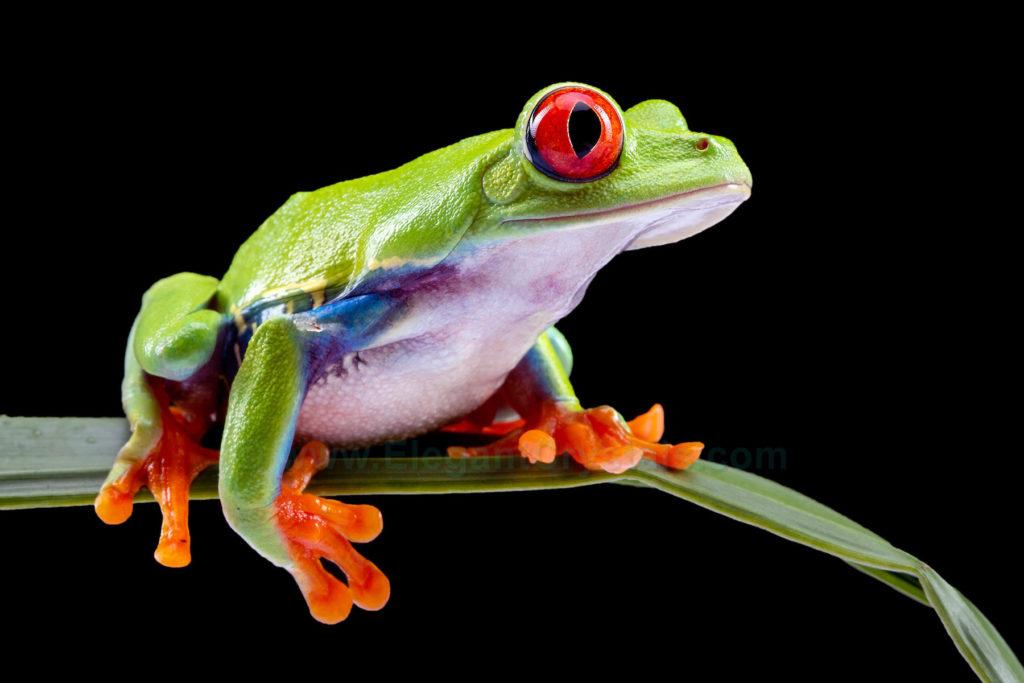
Picture #55
Red-eyed Tree Frog, Agalychnis callidryas
Photo by Dave Denby
Courtesy of Shutterstock.com
Frogs also use a combination of pigments and clear prismatic crystals.
There are usually three layers of prisms on the surface of the skin.
The deepest colored pigment is dark-colored melanin, found in almost all animals.
Then there is a zone of prismatic purine crystals.
These create a silvery blue iridescent reflection.
This bluish light combines with yellow pigment chemicals, related to carotene, resulting in a bright green color.
Between their glistening wet skin, and sophisticated colors, the frogs put on a fascinating light-show.
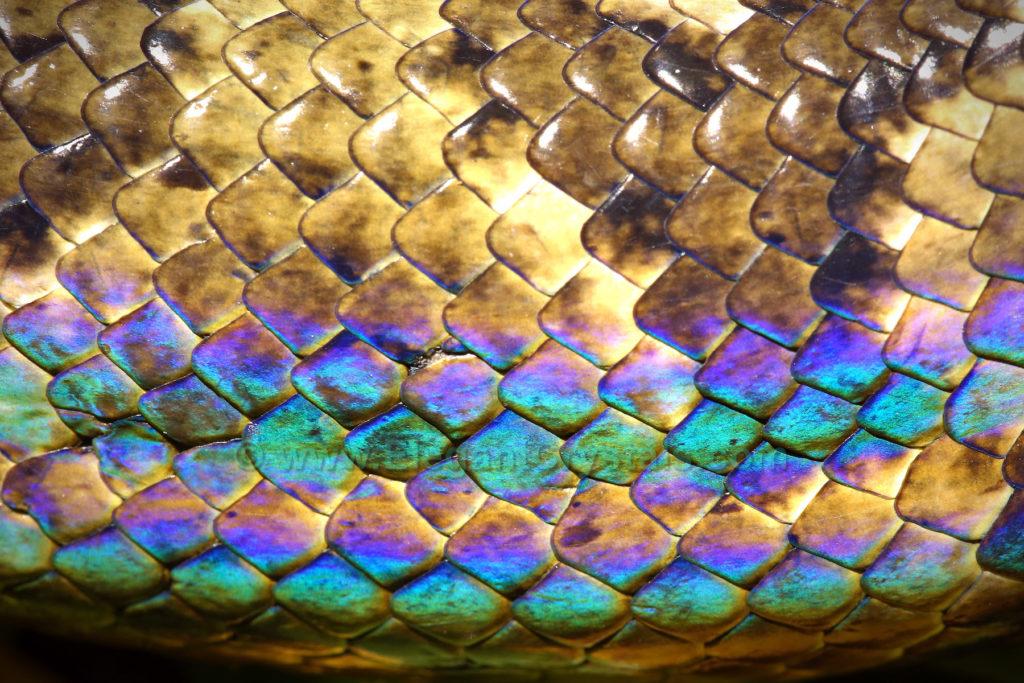
Picture #56
Tree Boa
Sanzinia madagascariensis, found in Madagascar
Photo by Ryan M. Bolton
Courtesy of Shutterstock.com
This non-poisonous snake can grow from four to seven feet long.
Dark colored snake species can show metallic sheens and bright iris colors.
As a kid, I used to have little snakes as pets, but this one is far too large and dangerous to keep at home.
All my little snakes escaped from their cages at one time or another.
I wouldn’t want to see one of these big boas get out of a cage, because they will try to eat almost anything.
The scale colors come from clear keratin crystals in the top layer of the snake’s skin.
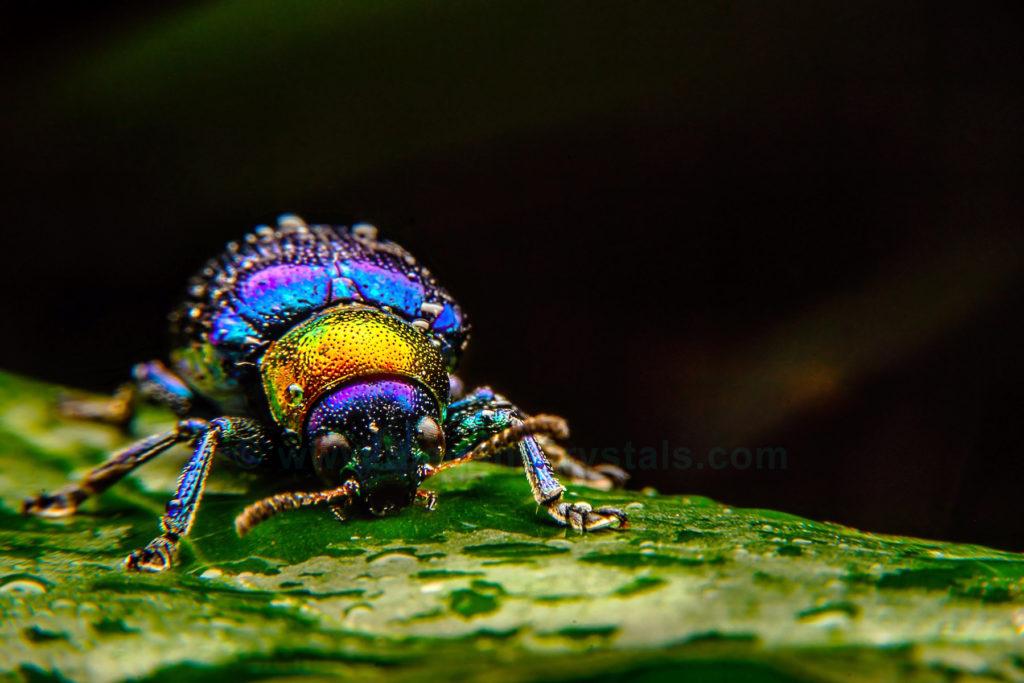
Picture #57
Metallic Leaf Beetle
Eumolpinae aiuruoca,
from Minas Gerais, Brazil
Photo by Ketkata Leejungphemphoon
Courtesy of Shutterstock.com
In the 30 million species of beetles that have been identified, thousands of them shimmer with rainbow light.
The insects use layers or spirals of chitin to refract and diffract light.
A dark underlying layer of melanin plays an important part as well.
It absorbs extraneous light frequencies that would otherwise tend to fade the intensity of the iridescence caused by the overlying layers.
Melanin underneath the surface is used to increase the contrast and intensity of iridescence in animals.
Like the other species we have looked at, beetles have evolved an array of mechanisms to manipulate light.
In the image here, the odd protruding bumps are part of a camouflage strategy that make the beetle look like drops of water instead of food for predators.
